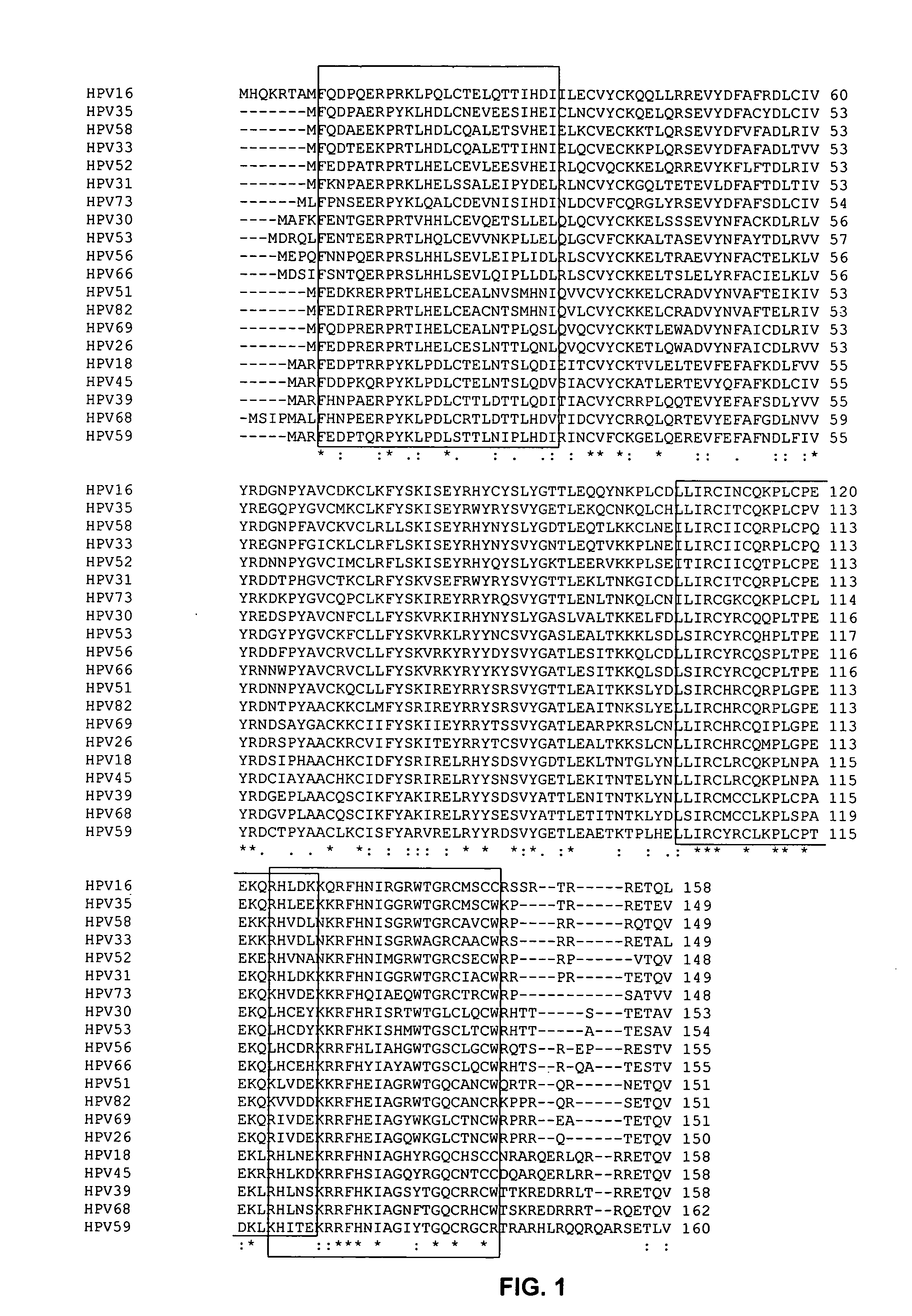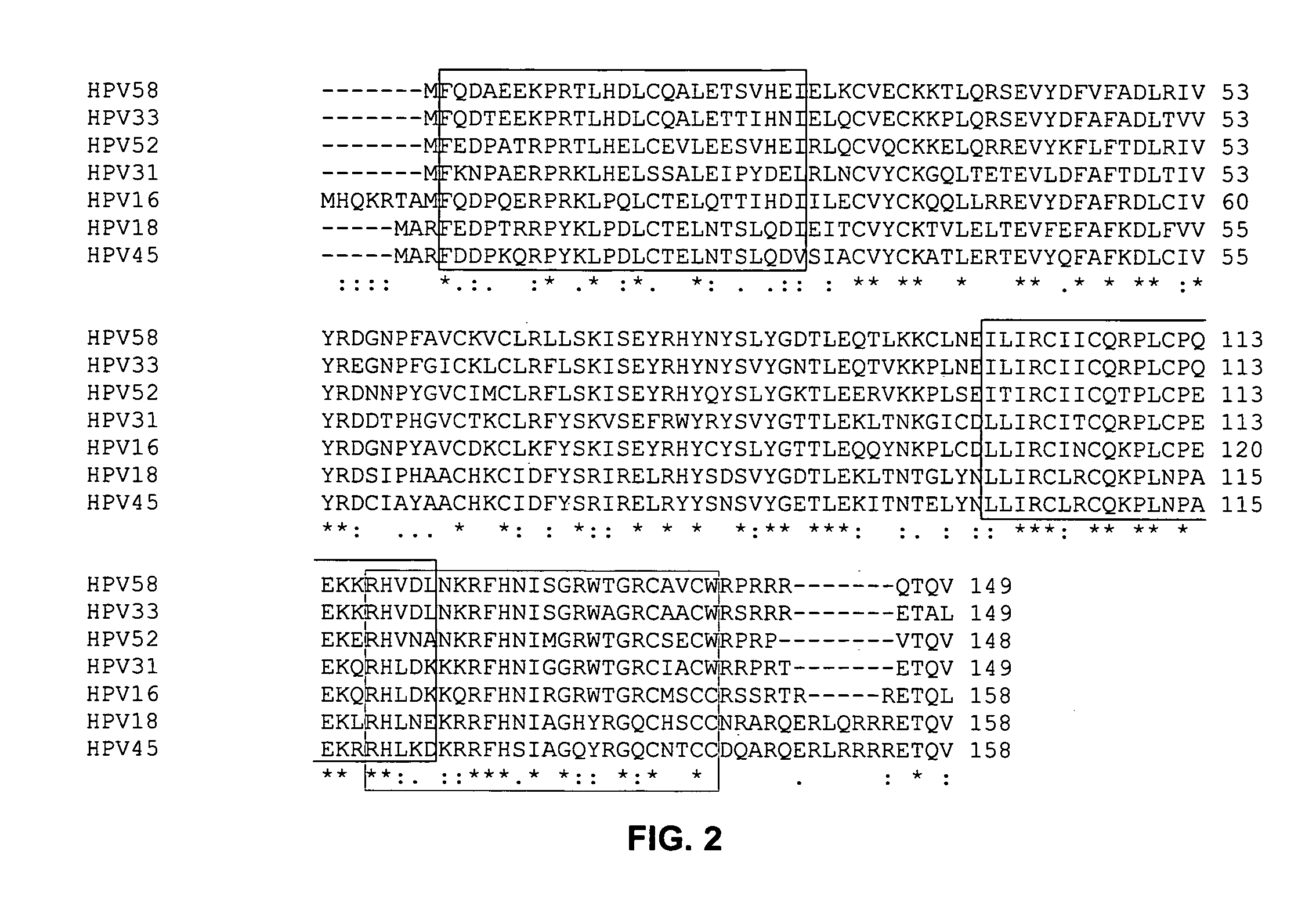Antibodies for oncogenic strains of HPV and methods of their use
a technology of human papillomavirus and antibodies, which is applied in the field of detection of oncogenic strains of human papillomavirus (hpv), can solve the problems of 5,000 deaths each year, inability to test in the world, and large number of infected persons
- Summary
- Abstract
- Description
- Claims
- Application Information
AI Technical Summary
Problems solved by technology
Method used
Image
Examples
example 1
Sequence Analysis of HPV E6 Proteins to Determine Oncogenic Potential
[0116]PDZ proteins are known to bind certain carboxyl-terminal sequences of proteins (PLs). PL sequences that bind PDZ domains are predictable, and have been described in greater detail in U.S. patent application Ser. Nos. 09 / 710,059, 09 / 724,553 and 09 / 688,017. One of the major classes of PL motifs is the set of proteins terminating in the sequences—X-(S / T)-X-(V / I / L). We have examined the C-terminal sequences of E6 proteins from a number of HPV strains. All of the strains determined to be oncogenic by the National Cancer Institute exhibit a consensus PDZ binding sequence. Those E6 proteins from papillomavirus strains that are not cancerous lack a sequence that would be predicted to bind to PDZ domains, thus suggesting that interaction with PDZ proteins is a prerequisite for causing cancer in humans. This correlation between presence of a PL and ability to cause cancer is 100% in the sequences examined (Table 3A). I...
example 2
Identification of PDZ Domains That Interact With the C-Termini of Oncogenic E6 Proteins
[0121]In order to determine the PDZ domains that can be used to detect oncogenic E6 proteins in a diagnostic assay, the assay was used to identify interactions between E6 PLs and PDZ domains. Peptides were synthesized corresponding to the C-terminal amino acid sequences of E6 proteins from oncogenic strains of human papillomavirus. These peptides were assessed for the ability to bind PDZ domains using an assay and PDZ proteins synthesized from the expression constructs described in greater detail in U.S. patent application Ser. Nos. 09 / 710,059, 09 / 724,553 and 09 / 688,017. Results of these assays that show a high binding affinity are listed in Table 4 below.
[0122]As we can see below, there a large number of PDZ domains that bind some of the oncogenic E6 proteins and the second PDZ domain from MAGI-1 binds all of the oncogenic E6 PLs tested. The PDZ domain of TIP-1 binds all but one of the oncogenic ...
example 3
HPV-E6 Recombinant Protein Expression and Purification
[0141]Polynucleotides encoding E6 proteins of high-risk HPV types listed above were chemically synthesized (DNA 2.0, Menlo Park, Calif.) or cloned via RT-PCR from cervical cancer cell lines. Both maltose-binding-protein-E6 (MBP-E6) and glutathione-S-transferase-E6 (GST-E6) fusion protein types were used. Production of GST-E6 and MBP-E6 proteins were by standard protocols recommended by the suppliers (Amersham and New England Biolabs, respectively). Proteins were expressed in DH5α E. coli using IPTG driven induction. A 2 h induction at 37° C. yielded GST-E6 or MBP-E6 recombinant proteins at ˜1 mg / L, whereas induction overnight at 20° C. and purification including rebinding of protein to the gel matrix resulted in final yield of 2-10 mg / L. Purity of MBP-E6 proteins was estimated to be >90% based on PAGE analysis. Recombinant E6 fusion proteins were used as immunogens.
PUM
| Property | Measurement | Unit |
|---|---|---|
| binding affinity | aaaaa | aaaaa |
Abstract
Description
Claims
Application Information
 Login to View More
Login to View More - R&D
- Intellectual Property
- Life Sciences
- Materials
- Tech Scout
- Unparalleled Data Quality
- Higher Quality Content
- 60% Fewer Hallucinations
Browse by: Latest US Patents, China's latest patents, Technical Efficacy Thesaurus, Application Domain, Technology Topic, Popular Technical Reports.
© 2025 PatSnap. All rights reserved.Legal|Privacy policy|Modern Slavery Act Transparency Statement|Sitemap|About US| Contact US: help@patsnap.com



